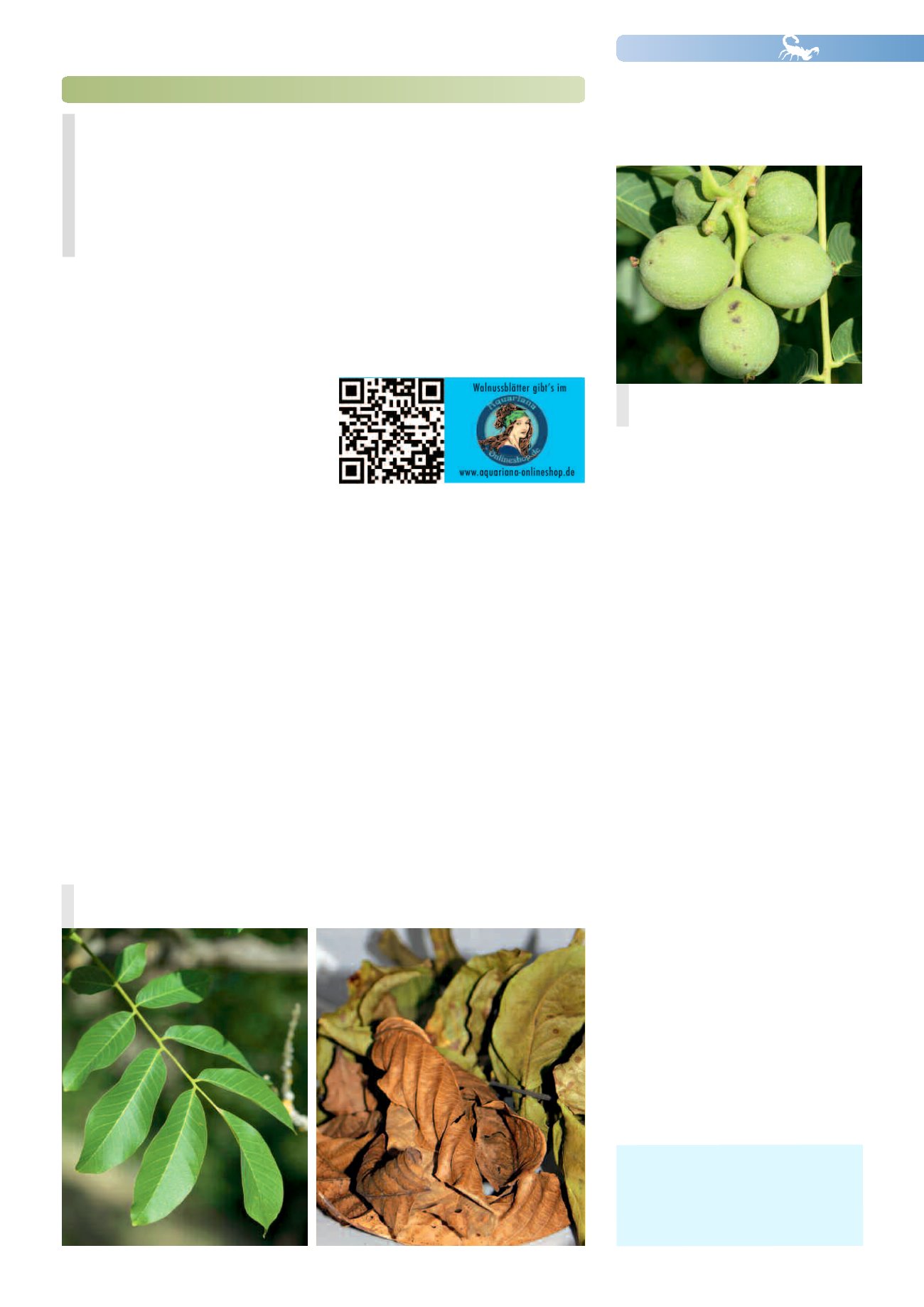
NEWS 110
43
The magic tree
Walnut trees can produce more than
tasty nuts...
by Birgit Bautz-Schäfer
alnut leaves have been used in
medicine since the timeof theAncient
Greeks. Applied externally, they are useful for
many skin diseases, in particular inflamed
wounds and boils,for eye infections,and other
troubles.Walnutleavesareparticularlyeffective
in the treatment of tuberculosis of the lymph
glands, so-called scrofula. And a decoction of
the leaves has also been used since time
immemorialforinternaluse againstirritationof
themucusmembranes anddiarrhea.
Greenor brown leaves?
As described in detail in the above-mentioned
article inNews 109,essentially it is better touse
brown autumn leaves in the aquarium, as
green leaves contain inter alia sugars that can
have a harmful effect on the aquarium water.
These sugars are used and broken down by
bacteria, and so cloudy water and lack of
oxygen can result from over-generous use of
green leaves.
However, some sorts of green leaves contain
Natural materials in the aquarium
Left on the tree,right dried ready for use in the aquarium: green (back) and brown (front) Walnut leaves have
quite different uses in the aquarium.
useful substances that are absent from the
brown autumn leaves. If you want to use
Walnut leaves for medicinal purposes, ie for
healing skin infections in fishes, then you will
need to use green leaves. And for use as food
the Walnut leaves should be harvested green
and then carefully dried - juveniles of many
loricariid catfishes, plus other herbivores such
as shrimps and crabs,like this food.
On the other hand the brown autumn leaves
canbeusedinexactlythesamewayasthoseof
Cattappa (the Sea Almond tree). They have a
gentle disinfectant and antibiotic effect. The
brown autumn leaves haveprovedparticularly
effective when placed in soft-water aquaria, as
they apparently have an inhibitory effect on
Numerous effective ingredients
According to a publication (Lagoni, 2008) from
the Bayerischen Landesanstalt für Wald- und
Forstwirtschaft (Bavarian State Institute for
WoodlandsandForestry)thegreenleavesofthe
Walnut contain a very large number of active
substances,including around 10%hydrolyzable
tannins, 3-4% flavonoids, various plant acids,
relatively large amounts of vitamin C, and the
famed juglone. Juglone is a natural dye that
produces an intense brown color. Anyone who
has shelled fresh walnuts will know all about
that.The tree uses the juglone to prevent other
plants from growing and thus avoiding
competition. Juglone has an antibacterial and
fungus-inhibiting effect.The amount of juglone
in Walnut leaves is heavily dependent on the
time of year. The highest level is found in the
young foliage (until around the end of June),
whilebrown autumn leaves contain virtually no
juglone.Soitisimportanttoknowwhichtypeof
leaves tocollect for aparticular purpose.
Walnut leaves are now offered by some
suppliers, for example by the Aquariana-
Onlineshop,whereyoucanbuylategreenleaves
(without a high juglone content, as food) and
brown autumn leaves (for prophylactic use
against disease).But the study of the use of the
healingpowersofWalnutleavesintheaquarium
hobby is still in its infancy,and lots of additional,
beneficial products canbe expected in the near
future.
In the last issue of the News we told you about the fundamental benefits of
leaves in the aquarium. In this issue we will discuss one of the most effective
sorts of leaves - those of theWalnut tree.
W
References:
Lagoni,N.(2008):
DerWalnussbaum – nu
̈
tzlich fu
̈
r
Pharmazie und Medizin.LWFWissen 60:54-58 in
Bayerische Landesanstalt fu
̈
rWald und
Forstwirtschaft
(Herausgeber): Beitra
̈
ge zur
Walnuss.LWFWissen No.60,70 pp.
thedreadedsoft-water parasite
Piscinoodinium
(velvet disease, generally incorrectly known as
Oodinium
).
The green outer shell of walnuts contains a
particularly large amount of juglone.


